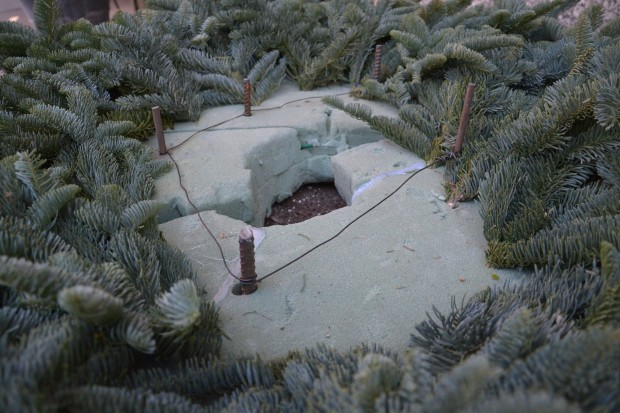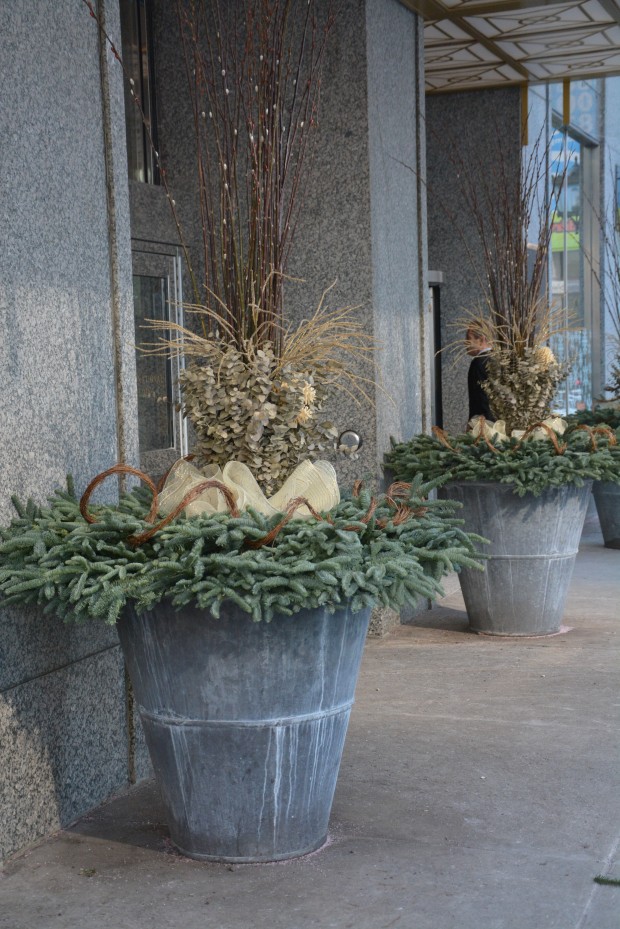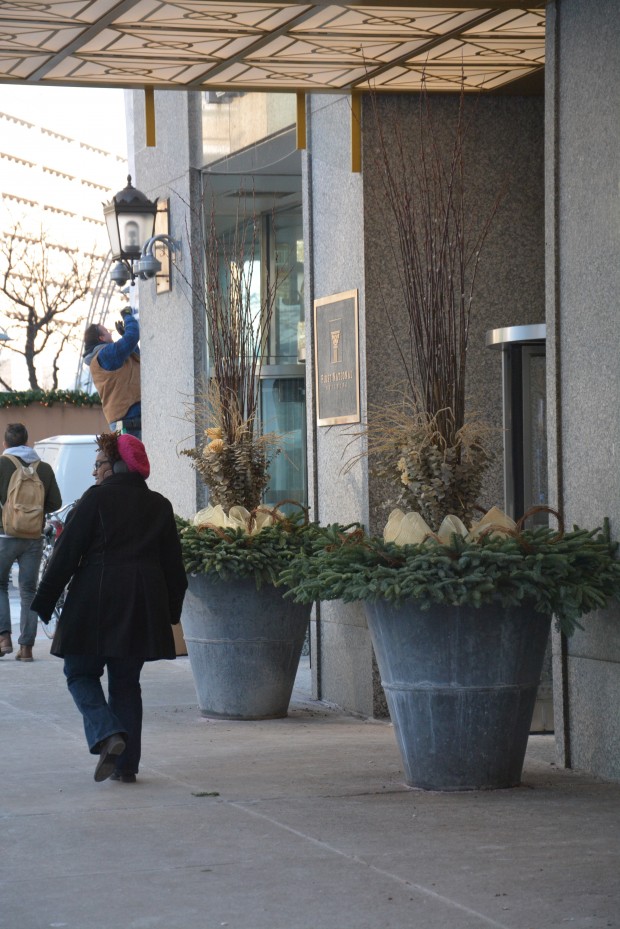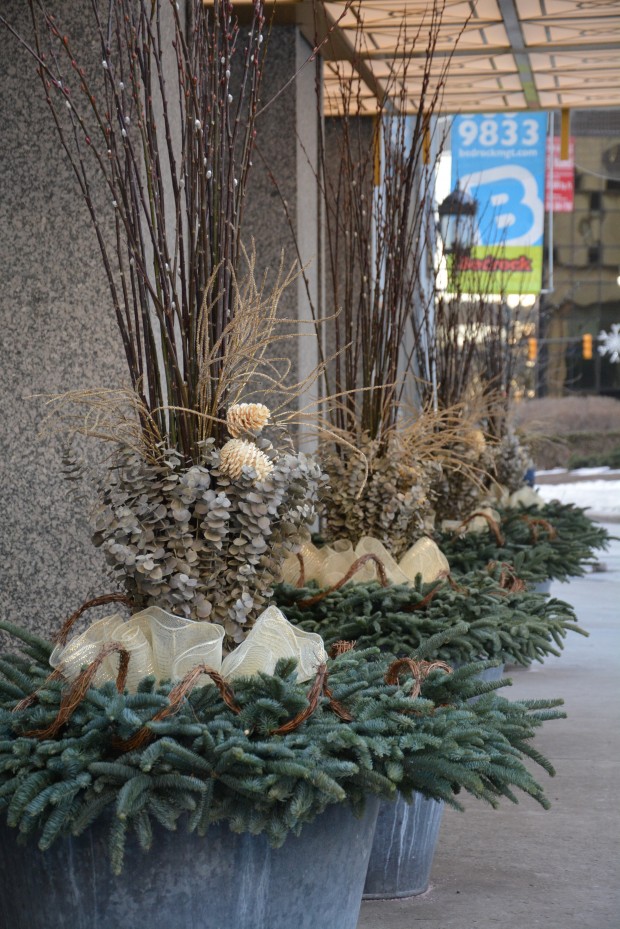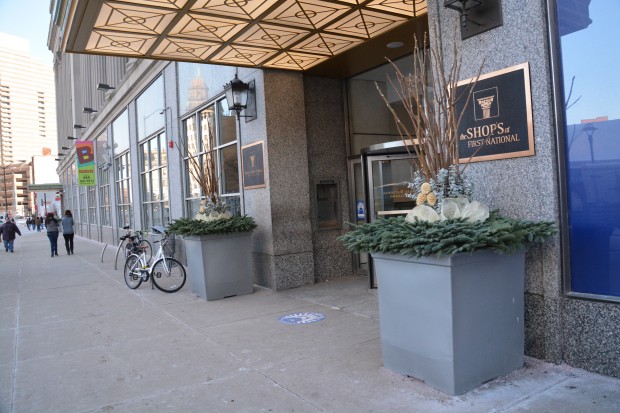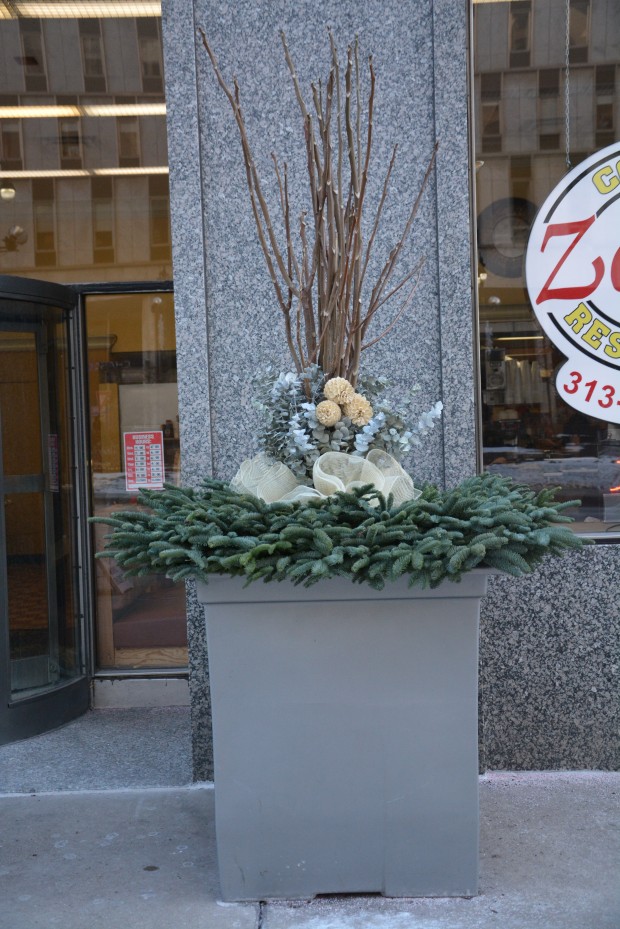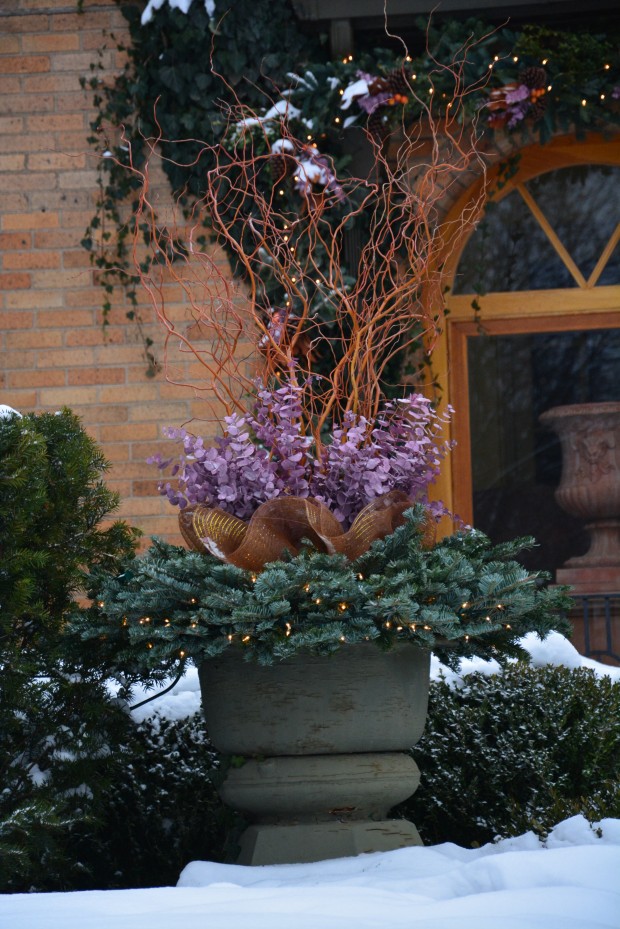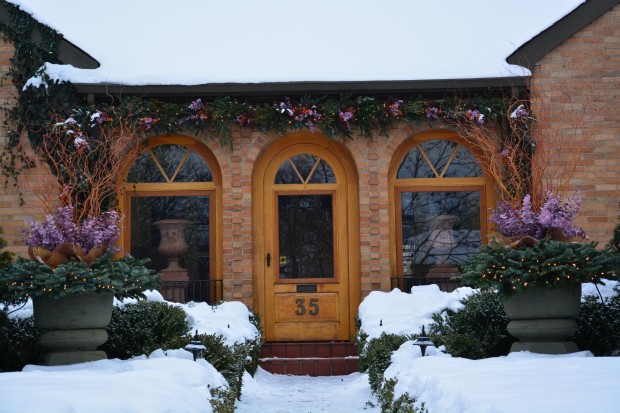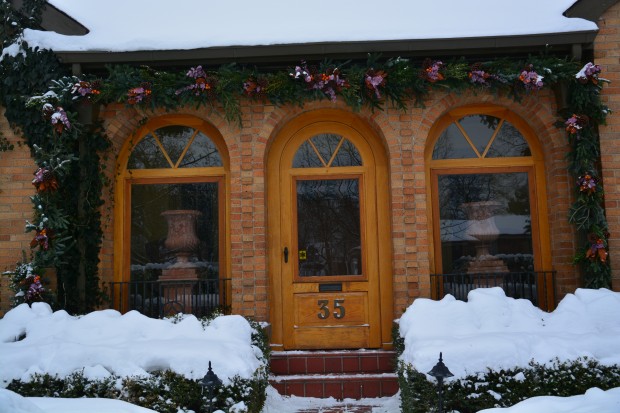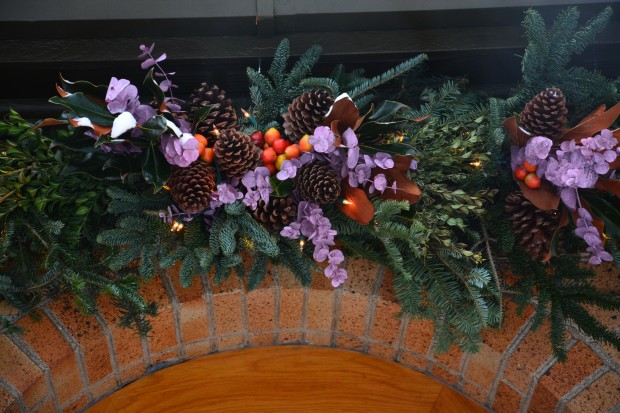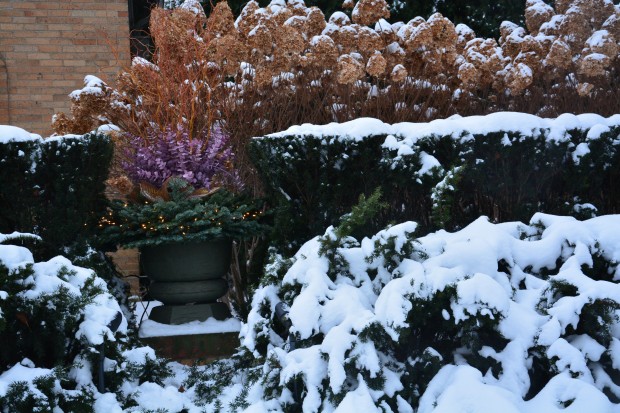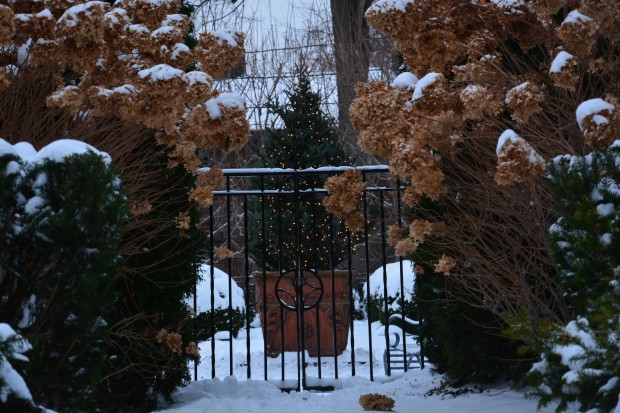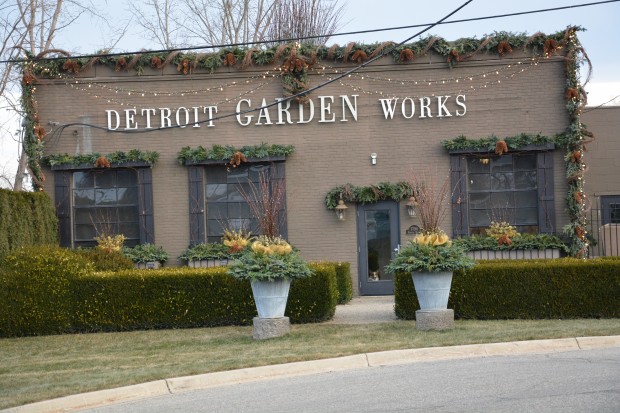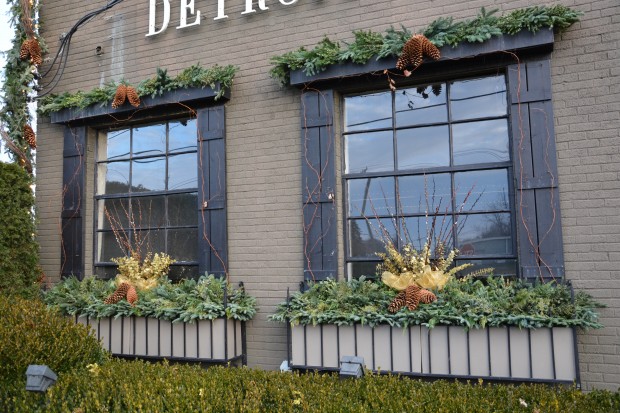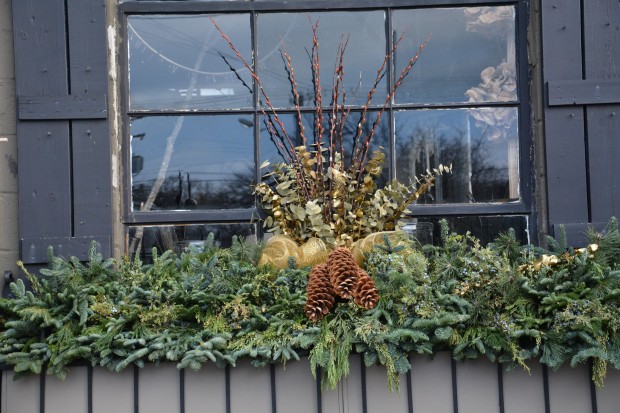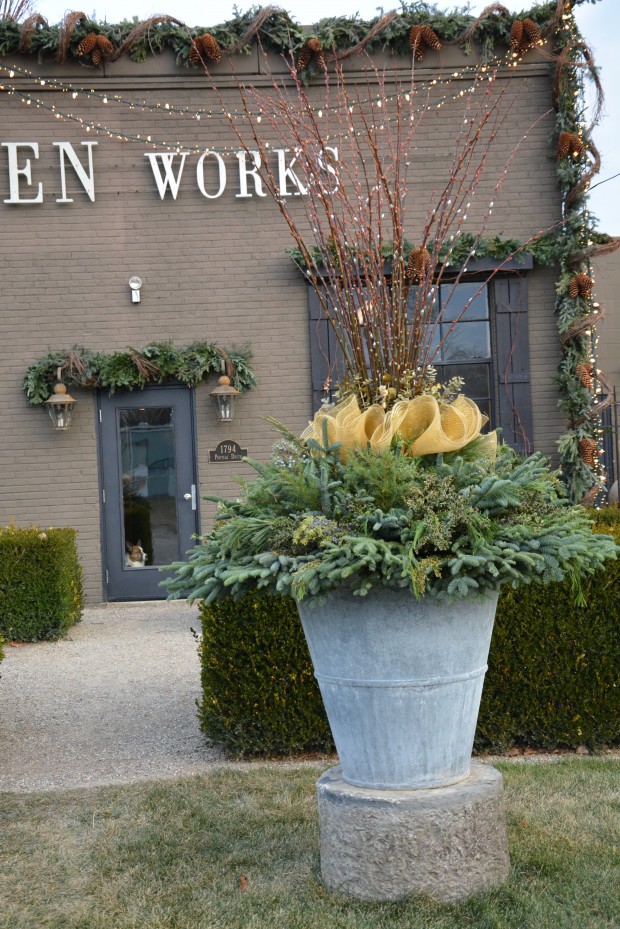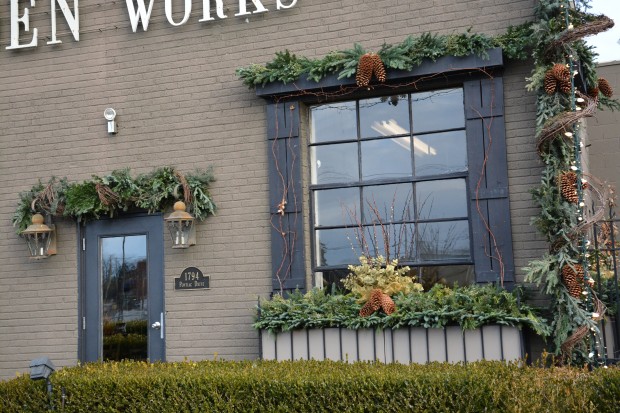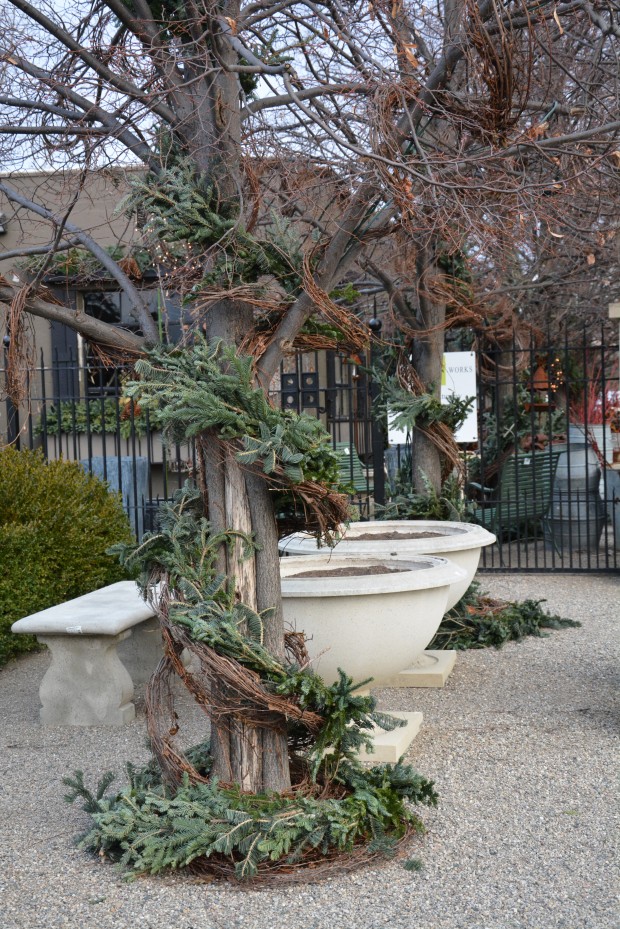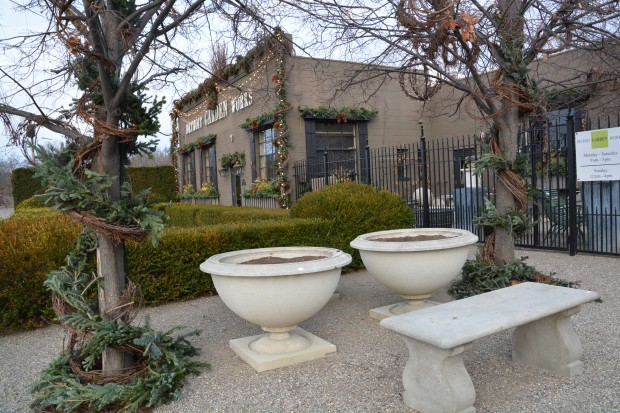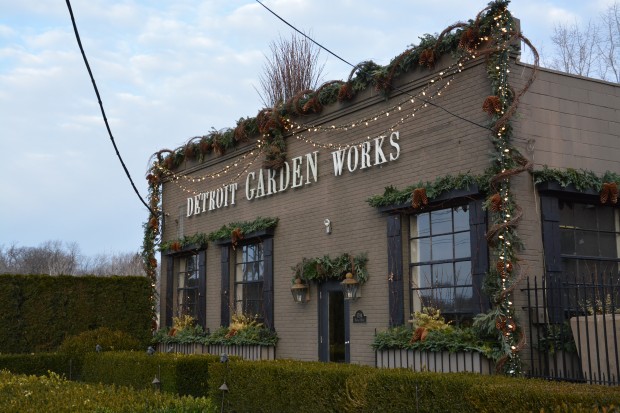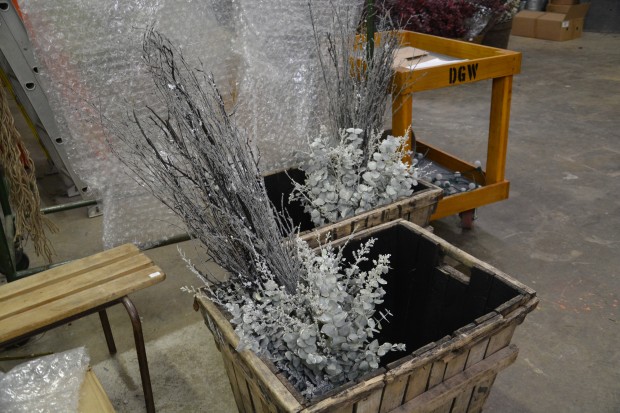 Some winter containers ask for a centerpiece. Small containers may not have room for lots of materials in them, stuck one stem at a time. A centerpiece only occupies a few inches of space in a container – the bamboo pole and all that is attached to it, driven down into the soil, provides all of the structural support. Some containers ask for height in the center. A structured centerpiece is a more formal arrangement, as it is visually stable and symmetrical. The centerpieces pictured above were set in a pair of antique French champagne grape crates for safe keeping only, once they were finished. The pots they were destined for are square, and formal. The placement on a front porch asks for enough height to be seen from the drive. As for these rectangular crates, they ask for an entirely different construction approach. More on the crates later next week. I like to call this alternative construction the Rob technique. Every winter and holiday container that he does for a client is deconstructed. His design evolves, one stem at a time.
Some winter containers ask for a centerpiece. Small containers may not have room for lots of materials in them, stuck one stem at a time. A centerpiece only occupies a few inches of space in a container – the bamboo pole and all that is attached to it, driven down into the soil, provides all of the structural support. Some containers ask for height in the center. A structured centerpiece is a more formal arrangement, as it is visually stable and symmetrical. The centerpieces pictured above were set in a pair of antique French champagne grape crates for safe keeping only, once they were finished. The pots they were destined for are square, and formal. The placement on a front porch asks for enough height to be seen from the drive. As for these rectangular crates, they ask for an entirely different construction approach. More on the crates later next week. I like to call this alternative construction the Rob technique. Every winter and holiday container that he does for a client is deconstructed. His design evolves, one stem at a time.
 My client with the formal square pots also has a pair of rectangular pots. All four are Jackie boxes, made at our company Branch. A centerpiece in a long box can look awkward and lonely. This client had a particular requirement for white, and light in the containers. We did the greens on the edges of the foam forms, loosely. All of the other materials would have to be inserted into the foam, one stem at a time. If a container arrangement asks for a one at a time treatment, the foam in the center may be three pieces thick. Creativity – we prize that individual expression. But the most creative work on the planet comes to no good if it goes over. As Buck would say, the approach to the work is important.
My client with the formal square pots also has a pair of rectangular pots. All four are Jackie boxes, made at our company Branch. A centerpiece in a long box can look awkward and lonely. This client had a particular requirement for white, and light in the containers. We did the greens on the edges of the foam forms, loosely. All of the other materials would have to be inserted into the foam, one stem at a time. If a container arrangement asks for a one at a time treatment, the foam in the center may be three pieces thick. Creativity – we prize that individual expression. But the most creative work on the planet comes to no good if it goes over. As Buck would say, the approach to the work is important.
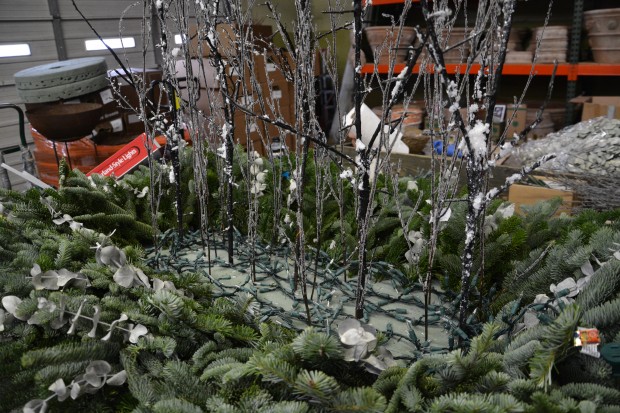
The center section of this rectangular form was dressed with a strand of garland lights. Garland lights are spaced very close together on the wire. One string has 300 lights. The lights are pinned into place with fern pins. A large rectangular planter asks for light which is dispersed all along its length, and strong enough to light from below all of the materials that come next. Back and forth-the light string gets set. The tallest of the stems are stuck deep enough into the foam layers to be stable, and in a roughly formal pattern.
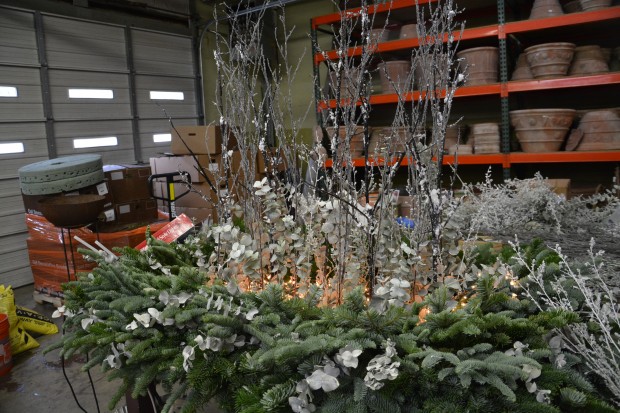 Once the lights are pinned to the foam, we turn them on for the entire duration of the construction. It is important to see how all of the other materials will relate to that light. For these containers, I stuck white eucalyptus and white leptospermum at different heights. One stem at a time. Any project that happens one gesture at a time takes the time it takes to think every gesture through. No matter how busy we are, Rob takes the time a project needs to be beautiful. He is an inspiration to me.
Once the lights are pinned to the foam, we turn them on for the entire duration of the construction. It is important to see how all of the other materials will relate to that light. For these containers, I stuck white eucalyptus and white leptospermum at different heights. One stem at a time. Any project that happens one gesture at a time takes the time it takes to think every gesture through. No matter how busy we are, Rob takes the time a project needs to be beautiful. He is an inspiration to me. 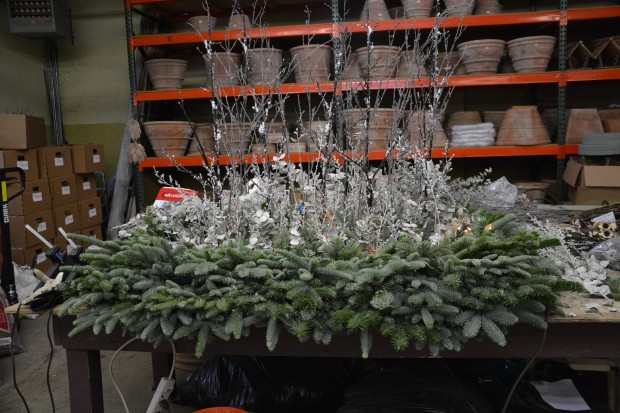 Constructing a winter container in the privacy of our garage means we can rfethink, fuss, adjust, and rearrange to our heart’s content, before we go live.
Constructing a winter container in the privacy of our garage means we can rfethink, fuss, adjust, and rearrange to our heart’s content, before we go live.
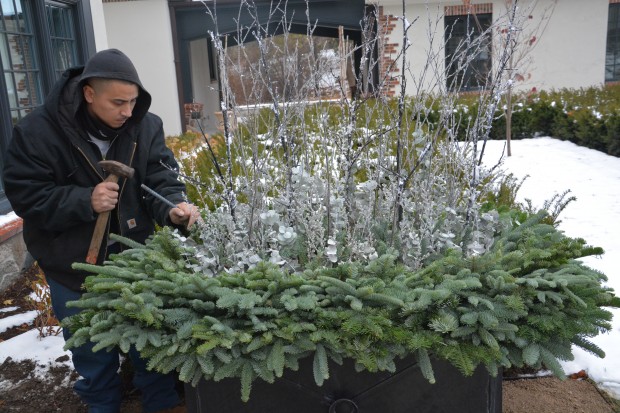 Once we get to the installation phase, we are done with the creative decisions. We just mean to install with many months of faithful service in mind. This arrangement is secured into the soil with pairs of long steel rebar, set at an angle. The rebar functions as roots. These natural materials are cut. We need to provide for the rooting a live plant will do naturally.
Once we get to the installation phase, we are done with the creative decisions. We just mean to install with many months of faithful service in mind. This arrangement is secured into the soil with pairs of long steel rebar, set at an angle. The rebar functions as roots. These natural materials are cut. We need to provide for the rooting a live plant will do naturally.
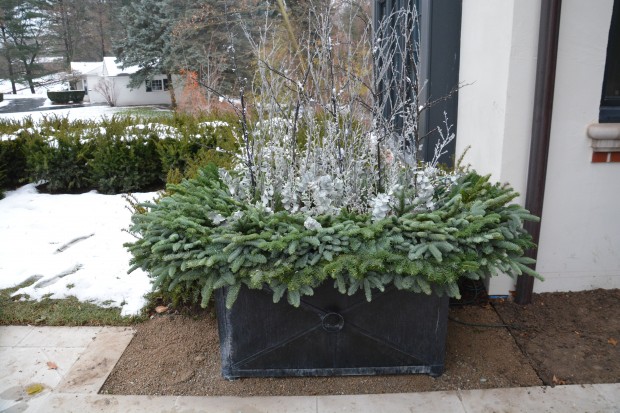 The finished container is stuffed with materials that will see the winter through. Each stem, stuck one at a time. These clients have an extraordinary appreciation and interest in the landscape. How I appreciate that they called on me.
The finished container is stuffed with materials that will see the winter through. Each stem, stuck one at a time. These clients have an extraordinary appreciation and interest in the landscape. How I appreciate that they called on me.
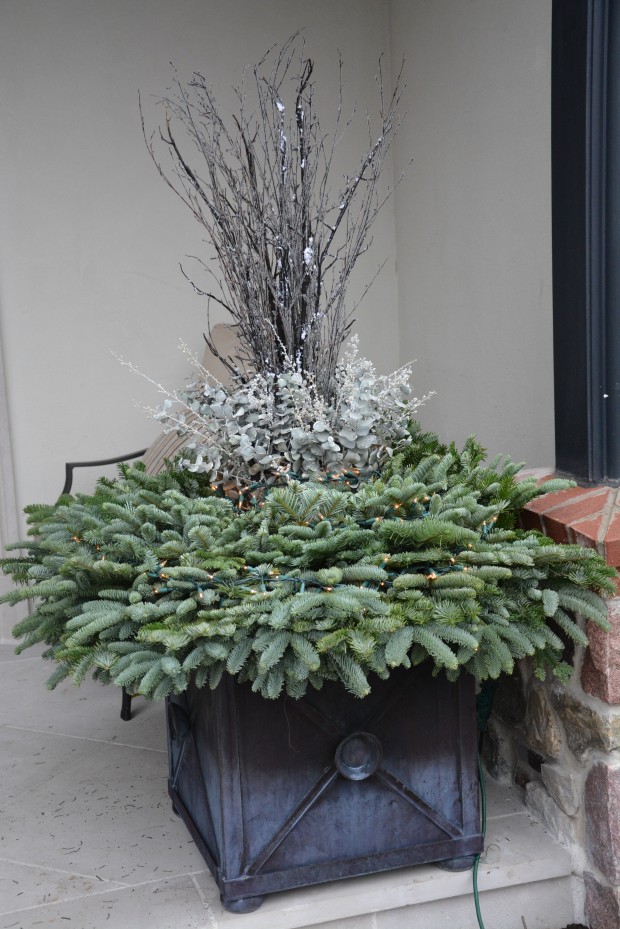 The smaller square boxes represent strongly – the centrally constructed centerpieces stand behind that formal statement. Good design takes so many factors into account. Successful design requires the meeting of so many minds. The client, first and foremost. The architecture. The space. The light.
The smaller square boxes represent strongly – the centrally constructed centerpieces stand behind that formal statement. Good design takes so many factors into account. Successful design requires the meeting of so many minds. The client, first and foremost. The architecture. The space. The light.
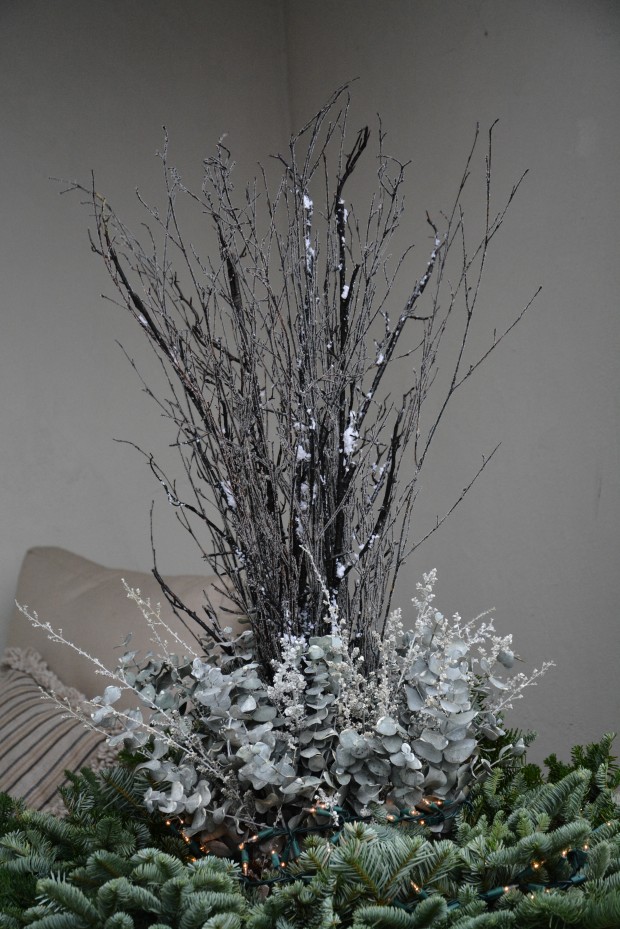 I encourage all of my clients to identify materials that appeal to them. I can plan around an idea. If you are your own client, take the time to ask the big questions before you set to the task. What do you like? What you like will greatly inform how you represent the winter season. There is no need to quit the garden, given the first really hard frost. There is only a need to switch gears a bit. Michigan has 6 months of winter-we are just beginning to express our rebuttal.
I encourage all of my clients to identify materials that appeal to them. I can plan around an idea. If you are your own client, take the time to ask the big questions before you set to the task. What do you like? What you like will greatly inform how you represent the winter season. There is no need to quit the garden, given the first really hard frost. There is only a need to switch gears a bit. Michigan has 6 months of winter-we are just beginning to express our rebuttal.
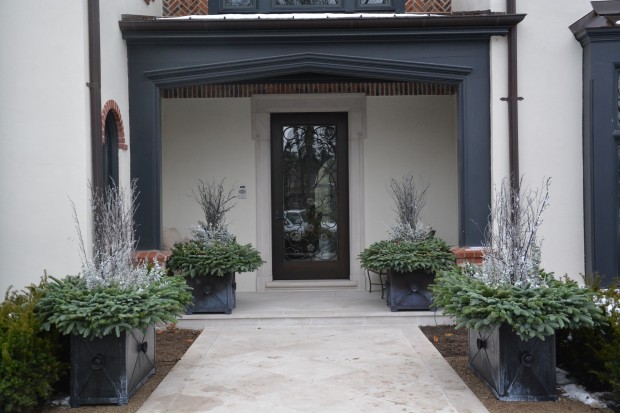 These boxes are dressed for the winter. Just how I envisioned them. I have heard that my client likes them. I am sure the light in the boxes at night will welcome friends and family. Whatever manner you choose to envision and decorate your winter landscape-please persist. Great joy accompanies great ideas.
These boxes are dressed for the winter. Just how I envisioned them. I have heard that my client likes them. I am sure the light in the boxes at night will welcome friends and family. Whatever manner you choose to envision and decorate your winter landscape-please persist. Great joy accompanies great ideas.


